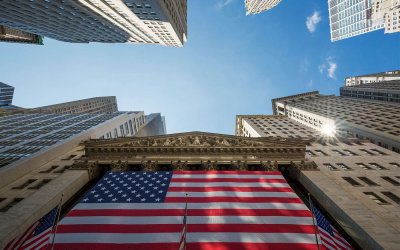A stock market crash is defined as a rapid and unexpected drop in the price of stocks and shares. They are typically short-lived events but can last anywhere from a few days to several weeks. And in some cases, they even evolve into a bear market.
There isn’t a specified threshold by which stocks have to drop below to be classified as a crash. However, most investment professionals agree that a crash is considered to have happened after a sudden double-digit percentage drop in a stock market index, such as the FTSE 100 or S&P 500.
The terms stock market crash, correction, pullback, and bear market are often used interchangeably. However, there are some stark differences between the three.
- Stock Market Pullback – A short-term drop between 5% and 10% that usually occurs over a few days.
- Stock Market Correction – A steady decline in stock prices between 10% and 20% over several weeks or months.
- Stock Market Crash – A rapid decline in stock prices greater than 20% over a short space of time.
- Bear Market – A prolonged decline in stock prices by more than 20%. In extreme cases, a bear market can last for years.
What causes a stock market crash?
The catalysts behind each stock market crash throughout history have been quite different. But a common theme that emerges across nearly all past events is a weakening economic outlook. As consumers slow their spending, corporate earnings struggle to achieve growth which can spark uncertainty, especially if stock valuations have reached high levels.
Some common factors that can trigger the start of a crash or correction include:
- High Inflation
- Rising Interest Rates
- Natural Disasters
- Overvalued Stocks
- Geopolitical Disputes
- Economic Uncertainty
- Excess Speculation
- Low Investor Sentiment
Looking at the various stock market crashes throughout history reveals just how diverse the causes of these events can be.
2020: The Covid-Crash
In early 2020 stock markets worldwide plummeted as entire countries went into lockdown due to the Covid-19 pandemic. With non-essential businesses being forced to close and international travel banned, global economies ground to a halt. And for many companies, especially smaller ones, this series of events led to bankruptcy.
However, following a massive injection of government stimulus, Western economies were able to bounce back at a record pace. And with 33 days, the FTSE 100 and S&P 500 indices had completely recovered before being propelled to new record highs.
2008: The Global Financial Crisis
After years of loose lending practices for mortgages by American banks, the US housing market became propped up on a massive pile of sub-prime loans. Eventually, millions of people across the country could not keep up with mortgage payments, leading to a surge in foreclosures. The market became flooded with properties and no one to buy them, causing house prices to plummet.
To make matters worse, investment banks were using complex derivatives such as Collateralised Debt Obligations (CDOs) to hide the level of risk within mortgage bonds. With bond rating agencies selling high ratings to the same investment banks, individual and professional investors unknowingly purchased extremely high-risk assets. This was particularly problematic for pension funds across the United States and Europe.
After default rates began to skyrocket, mortgage bonds collapsed, causing an estimated $1trn of losses worldwide. At the end of the financial crisis, the S&P 500 tumbled by as much as 57%, and it took approximately 17 months for the stock market to recover.
2000: The Dotcom Bubble
As the internet began to take the investment community by storm, online-based technology stocks became immensely popular, including businesses which didn’t even have a revenue stream. As mania took over, the valuation of technology stocks reached absurd levels, pushing the Nasdaq up by more than 500% between 1995 and 2000.
Eventually, the bubble burst and the Nasdaq collapsed by 77%. It would take 15 years before the index would return to its same level of valuation.
1973: The Oil Crisis
The stock market crash in 1973 was a fairly complicated situation triggered by many different factors. The US economy was already weakened after the decision to engage in the Vietnam war. Pairing this with increased social spending caused the country’s deficit to skyrocket.
At the time, the US dollar followed the gold standard, which meant the Federal Reserve had little control over economic policy. This ultimately led to the abolition of the gold standard in America in 1971. Two years later, the Organisation of Arab Petroleum Exporting Countries (OPEC) introduced an oil embargo on all countries that supported Israel in the Arab-Israeli war. The United States and the United Kingdom were on the list.
What followed was a sudden supply shock for oil. Prices for the fossil fuel more than tripled in a matter of weeks and crippled the US economy for nearly a decade. The Dow Jones Industrial Average dropped by as much as 45%, while the UK’s FT 30 index – one of the oldest indices in the world – dropped by as much as 73%.
The stock recovered within 21 months. But what followed was nearly a decade of multiple recessions, triggering one of the longest bear markets in history.
1929: The Great Depression
Following the roaring 20s after World War 1, the US economy expanded rapidly, with the nation’s wealth more than doubled. As the economy was booming, the level of speculation on Wall Street started to get out of hand, with seemingly everyone pouring their money into stocks and shares. And many were even using margin to try and amplify their returns.
The Dow Jones Industrial Average hit its peak in August 1929. After a slight slowdown in US production and an increase in unemployment, investors started to get spooked, resulting in a panic-selling frenzy that saw a record 12.9 million shares being sold off on what’s now known as Black Thursday.
Things seemed settled for a few days. But then, on October 29, now known as Black Tuesday, this record trading volume was beaten with 16 million shares being sold off. Investors across the United States saw their investments collapse. And most who were using margins put themselves in personal bankruptcy.
The Great Depression is by far one of the worst declines in the history of financial markets. By the time the dust had settled, the Dow Jones had dropped by 89%. And it would take close to 25 years to recover to its former high.
Are market crashes bad for investors?
As horrendous as experiencing a stock market crash first-hand can be, it can also provide some rare advantages.
As most investors enter into a panic-selling frenzy, plenty of high-quality businesses can get caught in the crossfire. Some tremendous buying opportunities can emerge for those capable of identifying the strong enterprises from the weak while valuations plummet.
The downward trend of the stock market can also cool down overheated stock prices driven by speculation rather than underlying fundamentals. This can be beneficial if asset price inflation starts to get out of control.
Of course, these advantages come paired with some pretty severe setbacks for investors, especially short-term traders. Sudden downward pressure leaves little time for individuals to pull their capital out of the market before stock prices plummet. And all too often, investors sell after shares have already collapsed, leading to the destruction of wealth.
The severity of this effect is also often amplified by traders short-selling to try and profit from the decline of stock prices. Depending on how bad the situation gets and the underlying trigger, stock market crashes can transform into a deeper bear market and even an economic recession.
So, are stock market crashes bad? Yes. But they also create lucrative opportunities for prudent investors.
How often does the stock market crash?
A stock market crash, by its nature, is unpredictable. While there are leading indicators suggesting a down period may be due to occur, these are often wrong. And even professional investors constantly make predictions that fail to materialise.
Having said that, on average, a stock market crash occurs once every seven years. At least, that’s what history has shown. But in practice, this schedule is rarely followed. For example, after the 2008 global financial crisis, it took nearly 11 years before another crash occurred in 2020, marking one of the longest bull markets in history. For the investors that sold their shares in 2015 as per the seven-year schedule missed out on another five years of stock market growth.
How long does a market crash last?
The duration of a stock market crash ultimately depends on what caused it in the first place. For example, a severe economic downturn will take far longer to recover than a short-term supply shock.
Looking at the S&P 500 since 1950 reveals that roughly 63% of stock market crashes and corrections last between two weeks to three and a half months before reaching the bottom. However, on average, it can take up to 18 months before shares recover to their former levels.
How can investors prepare for a stock market crash?
While a stock market crash is incredibly difficult to predict, that doesn’t mean investors can’t prepare. And several steps can be taken to mitigate the impact of a market downturn on an investment portfolio.
- Build A Cash Buffer – One of the biggest mistakes investors make during a stock market crash is to sell shares after the price has collapsed. However, those who need money to cover living expenses may have no choice but to sell at a terrible price. This risk can be mitigated by ensuring sufficient cash is kept in reserve in a savings account.
- Diversify – Stock market crashes can hit different industries at varying degrees of severity. The risk of owning shares in the most heavily impacted industry is reduced by ensuring a portfolio containing a wide range of sectors. Similarly, allocating capital across a broad range of alternative asset classes, such as bonds and real estate, can further mitigate the impact of rapidly declining stock prices.
- Keep Spare Capital – With panicking investors selling off anything with a pulse, rare buying opportunities for top-notch companies may emerge. By ensuring some capital is kept in reserve, investors will have the money to capitalise on these investment opportunities.
What should investors do during a market crash?
For investors seeking to capitalise on the buying opportunities that a stock market crash can create, a few considerations need to be taken into account. The most prominent is the heightened level of volatility.
When investor sentiment is low, the slightest bit of bad news can send stocks plummeting. Even if an investor identifies a terrific company trading significantly below its intrinsic valuation, shares can still fall further. Trying to predict when the market or an individual stock has hit its lowest point is a near-impossible task.
Fortunately, there are a few tactics that investors can deploy to mitigate downside risk:
- Pound-Cost Averaging – Instead of investing all residual capital in one go, investors can break it up into smaller chunks and drip-feed it into the markets. That way, investors can buy more at an even better price if an undervalued stock continues to fall. Each time a lower price is paid, the average cost per share in an investment falls, reducing the impact of further price declines after the initial trade.
- Stop-Loss Orders – To protect against downside risk, investors can set up a stop-loss order. This is a set of instructions given to a brokerage firm that states that if a company’s share price falls below a certain threshold, the broker should sell the investor’s shares. This can reduce the impact of a severe valuation decline.
- Stop-Limit Orders – This type of trade works similarly to a stop-loss order. However, the key difference is that the investor doesn’t close out their entire position. Instead, they can specify how many shares should be sold if a stock price falls below a specified threshold. This also works in reverse. Instead of selling shares, a stop-limit order can be used to buy a specified number of shares once the stock price meets a specified price level.
The bottom line
Stock market crashes are mostly unpredictable and inevitable events that come with the territory of investing. Investors should construct their portfolios with this risk factor in mind. And ensure that sufficient financial planning has been performed in case the worst comes to pass.
Discover market-beating stock ideas today. Join our Premium investing service to get instant access to analyst opinions, in-depth research, our Moonshot Opportunities, and more. Learn More
This article contains general educational information only. It does not take into account the personal financial situation of the reader. Tax treatment is dependent on individual circumstances that may change in the future, and this article does not constitute any form of tax advice. Before committing to any investment decision, an investor must consider their individual financial circumstances and reach out to an independent financial advisor if necessary.





